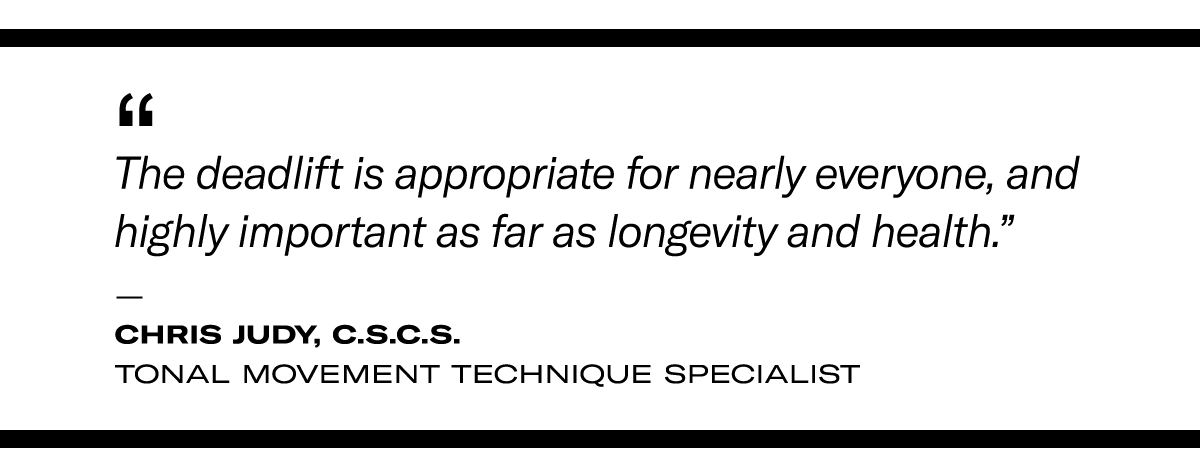The granddaddy of all lifts builds power and strength, helping you work out better and tackle everyday tasks more safely.

If you’ve ever lifted any object off the ground, you’ve done a deadlift. And because we all have to lift things and move them from place to place every day, it’s essential that we are able to perform this movement properly and safely.
The deadlift involves hinging at the hips and bending at the knees and replicates proper technique for lifting any object, from an overstuffed suitcase to a sleeping toddler. It’s also unparalleled in its simplicity, unrivaled in its ability to increase full-body strength and athleticism, and accessible to many.
“The deadlift is appropriate for nearly everyone, and highly important as far as longevity and health go,” says Tonal movement technique specialist Chris Judy, C.S.C.S. “Being able to pick something up off the ground is the essence of being able to utilize and control your body across multiple joints. That’s human nature.”
Here’s how to set yourself up to reap all the benefits deadlifts have to offer.
How to Do a Deadlift
- With a barbell, begin with feet hip-width distance apart with the hands just outside the hips, the shoulders slightly in front of the bar and the bar over the middle of the foot.
- Send the hips back and slightly bend the knees to grab the bar. Keep the toes pointing straight ahead (not turned out) and push the knees outward into the elbows to create full-body tension.
- With the feet flat on the floor and core engaged, drive through your heels to push the floor away as you rise to full hip and knee extension with arms straight.
- The back should remain flat and braced, the chest should be up and proud, and the hips and shoulders should rise at the same rate.
- Sit back into the hips and slide the bar down your thighs, pulling the bar into the legs to keep the back braced, and return to the starting position.
- If your thoracic spine or lumbar spine round as you pull the weight off the floor, and you’re unable to keep them flat by paying more attention, lower the weight.
If using Tonal’s handles (or free weights) to do a neutral-grip deadlift, start with the weight in line with your shoelaces and keep the arms straight at your sides as you lift and lower the weight.
Common Deadlift Mistakes
Feet Too Wide: As Judy explains, feet should be hip-width apart, which is narrower than the shoulder-width stance used for a squat. Too wide of a stance puts extra strain on the knees and can cause the shoulders to round forward.
Rounded or Arched Back: To avoid putting too much stress on the lower back, maintain a flat back, or neutral spine. This also applies to your head. Do not look up; keep the neck in line with the spine.
Rounded Shoulders: When the shoulders round forward, the spine is compromised. “Roll the shoulders back and keep the chest proud,” Judy says.
Squatting: The deadlift is predominantly a hip-hinge movement, not a squat variation. The knees should bend just enough for you to grip the bar without your back rounding forward. Drop too low and you’ll be in an inefficient position to lift the bar.
Extending the Legs First: When the hips shoot up too quickly without the bar moving off the floor, it puts extra stress on the lower back. Pressing the knees into the elbows at setup to create full-body tension can help keep the hips and chest moving in unison as you lift, says Judy. This will both keep you safe and help you to complete your lift.
Distance from the Bar: Many beginner deadlifters set up too far from the bar, or allow it to get too far away during the lift, which costs power. “The bar should stay in contact with your shins the whole way up to ensure the proper vertical pathway,” Judy says.

The Benefits of Deadlifts
Strengthen Your Entire Body
Many people think of the deadlift as primarily a posterior chain exercise that works the muscles on the back of your body, because that is where you’ll often feel the most sore after a heavy deadlift day. However, Judy points out that nothing moves in isolation and the deadlift benefits much more than just your back body.
“To do a deadlift properly, you use nearly every single muscle in your body for either stabilization or as an agonist for lifting the weight,” Judy says. “There is no muscle that is relaxed.”
The deadlift activates the entire kinetic chain. You’ll use your glutes, hamstrings, quads, and even calves to lift the bar off the floor with the core and lower back engaged to stabilize the spine. The upper back is activated to support the torso as you pull the weight from the ground, your biceps and shoulders keep the arms locked into position, and your grip is strengthened from working to hold the bar.
Because of this full-body activation, deadlifts develop strength, speed, power, and muscular endurance. They are also incredibly effective for improving jumping performance, because deadlifts teach you to develop power in the lower body.
Reduce Lower Back Pain
Though many people avoid deadlifts because they have lower back issues, deadlifts are actually proven to reduce lower back pain. And if you haven’t had a back injury, proper deadlifts will strengthen your lower back so you don’t develop back pain in the future. They also help to keep the shoulders, hips and spine in alignment, which improves posture and further reduces the risk of back pain. However, as with all new exercises and workout programs, check with your doctor or care team ahead of time if you have questions or concerns.
To build up confidence and strength for deadlifting, Judy suggests strengthening your entire core, including the glutes, lower back, mid back and hip flexors in addition to the abdominals first, and focusing on lifting lighter weight with perfect mechanics.
Judy also points out that if you hurt your back doing a deadlift, but you spent the three days prior lifting your grandkids with improper form, it might not actually be the deadlift that is to blame. “Doing deadlifts can re-train you how to lift properly across the board, so when it’s time to train, you’re not already fatigued and spasming from a poor movement pattern,” he says.
Build Your Other Lifts and Your Confidence
For many people, the deadlift is the lift that allows you to handle the most weight because the range of motion in the deadlift is so small and failed lifts bring less risk of injury because the weight is not on top of you. “It feels empowering to lift heavy weight and nothing builds confidence more than seeing that number shoot up,” says Judy.
But the deadlift boosts more than just your ego. Your body makes strength adaptations to the heavy weight lifted during deadlifts, and those adaptations carry over to other compound movements such as the bench press and squat. Because the mechanics of the deadlift are simple, Judy says it is also a great movement to train the breath control and timing the inhale and exhale that is necessary for other lifts.
Deadlift Variations–When You’re Ready

Once you’ve mastered the basic deadlift, you can progress to more complicated variations of the movement, like Romanian deadlifts, which are done with straight legs, or single-legged variations. But, it’s important to remember those are actually more advanced moves that require greater strength, coordination and skill. With the Romanian deadlift, Judy points out that removing a lot of your legs from the sequence forces the glutes to work harder, and if you’re not firing them properly, you’ll put too much strain on the lower back. Single-leg movements add a balancing component, which also adds difficulty. “People assume single-leg variations are easier because they’re done with lighter weight, but in reality, they’re harder, because they require balance on top of all the tension you need to create,” Judy explains.
But, even the standard deadlift will bring fast improvements in your fitness, and it is simple enough for everyone to safely master. “All you’re doing is picking a weight up off the ground and standing up,” Judy says.


